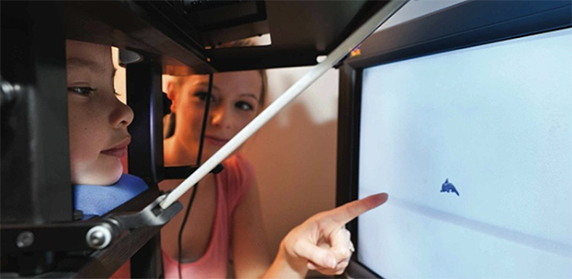by Dr Hayley Crawford, Centre for research in Psychology, Behaviour and Achievement
Fragile X syndrome is associated with social difficulties and an increased prevalence of autism spectrum disorder. The ability to interact successfully with others involves processing social information, such as interpreting cues from other people’s faces.
In a recent study, Hayley Crawford and colleagues from the University of Birmingham conducted a study of males with Fragile X syndrome and males with autism spectrum disorder, to investigate where they look on other people’s faces. This can tell us about the information that people are taking in when they look at faces. This study used eye-tracking technology to record eye movements when children and adults were presented with pictures of faces on a computer screen.
“We use eye-tracking technology because it is important to include children and adults with limited verbal abilities in our studies and eye-tracking doesn’t require a verbal response. It is also a very good tool for understanding how people process information. For example, we can find out what grabs people’s attention as this is usually the first thing they look at.”
Dr Hayley Crawford, Centre for research in Psychology, Behaviour and Achievement
Two main findings emerged from the study. Firstly, individuals with Fragile X syndrome spent less time looking at the eye region of faces compared to individuals with autism spectrum disorder. Although they looked to the eye region at the same speed, people with Fragile X syndrome also looked away quicker, resulting in overall reduced looking to the eye area of the face. Secondly, people with Fragile X syndrome appeared to successfully tell the difference between positive, negative and neutral emotional expressions. Specifically, people with Fragile X syndrome showed the same looking patterns to faces displaying an emotion as people without Fragile X syndrome. People looked longer at faces displaying a disgusted expression than a neutral expression, indicating that they are naturally telling the difference between the two.
“Parents have talked to us about their children’s social skills and eye gaze aversion. In this study, we have been able to investigate this and compare eye gaze in people with Fragile X syndrome to people with autism spectrum disorder, where reduced eye gaze is also commonly reported. This seemed particularly important given the overlap in behavioural features between Fragile X syndrome and autism spectrum disorder. These results suggest that there are meaningful differences in eye gaze in Fragile X syndrome and autism spectrum disorder. We were also able to show that, despite reduced eye gaze, people with Fragile X syndrome were able to spontaneously discriminate between emotions in the same way as typically developing children. This is an important social skill. We hope that by highlighting differences in the way in which people process social information, we can understand more about the social difficulties they may experience.”
Hayley Crawford.
This has helped to further understand the subtle but important differences in the mechanisms underlying social difficulties in those with Fragile X syndrome and autism spectrum disorder. Identifying differences between Fragile X syndrome and autism spectrum disorder has important implications for interventions. Due to the behavioural similarities, the suggested interventions may be the same. By highlighting subtle differences in the way in which people with Fragile X syndrome and autism spectrum disorder process social information, we are getting closer to being able to suggest that more targeted interventions should be designed for people with Fragile X syndrome and the difficulties they may face.
The Fragile X Society, UK, provided assistance to recruit participants for this study. This study was funded by the ESRC and has been published in the American Journal on Intellectual and Developmental Disabilities:
Originally featured in ‘The Fragile X Society’




Comments are disabled